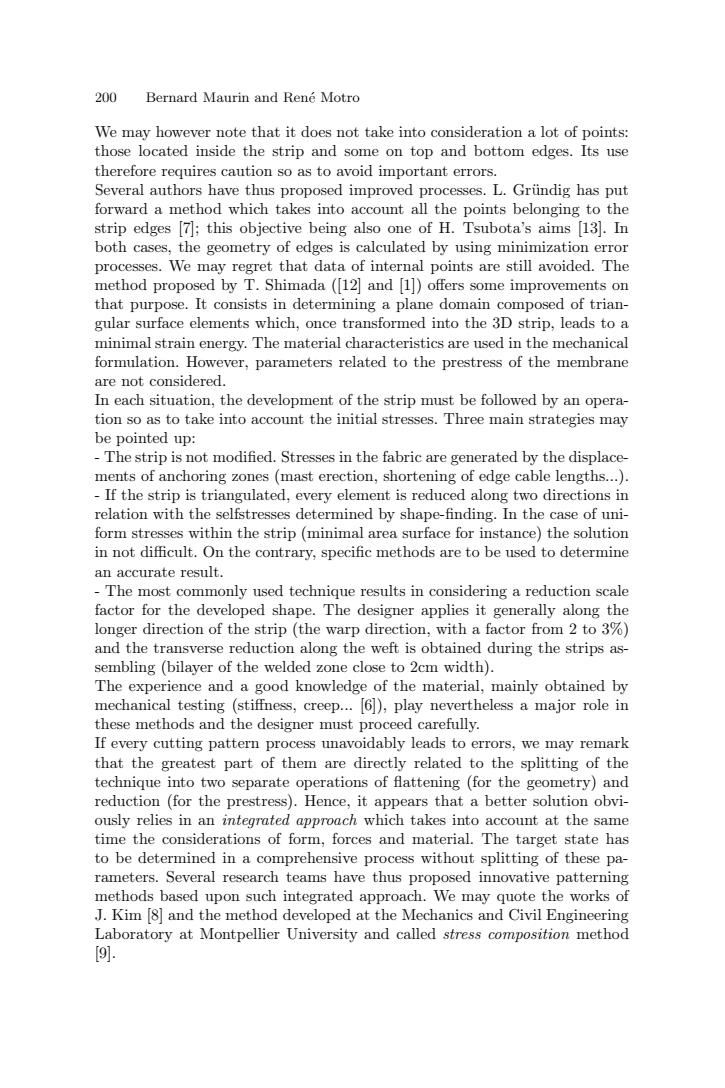正在加载图片...

200 Bernard Maurin and Rene Motro We may however note that it does not take into consideration a lot of points: those located inside the strip and some on top and bottom edges.Its use therefore requires caution so as to avoid important errors. Several authors have thus proposed improved processes.L.Gruindig has put forward a method which takes into account all the points belonging to the strip edges 7;this objective being also one of H.Tsubota's aims [13].In both cases,the geometry of edges is calculated by using minimization error processes.We may regret that data of internal points are still avoided.The method proposed by T.Shimada ([12 and [1])offers some improvements on that purpose.It consists in determining a plane domain composed of trian- gular surface elements which,once transformed into the 3D strip,leads to a minimal strain energy.The material characteristics are used in the mechanical formulation.However,parameters related to the prestress of the membrane are not considered. In each situation,the development of the strip must be followed by an opera- tion so as to take into account the initial stresses.Three main strategies may be pointed up: -The strip is not modified.Stresses in the fabric are generated by the displace- ments of anchoring zones (mast erection,shortening of edge cable lengths...). -If the strip is triangulated,every element is reduced along two directions in relation with the selfstresses determined by shape-finding.In the case of uni- form stresses within the strip(minimal area surface for instance)the solution in not difficult.On the contrary,specific methods are to be used to determine an accurate result. -The most commonly used technique results in considering a reduction scale factor for the developed shape.The designer applies it generally along the longer direction of the strip (the warp direction,with a factor from 2 to 3%) and the transverse reduction along the weft is obtained during the strips as- sembling (bilayer of the welded zone close to 2cm width). The experience and a good knowledge of the material,mainly obtained by mechanical testing (stiffness,creep...[6),play nevertheless a major role in these methods and the designer must proceed carefully. If every cutting pattern process unavoidably leads to errors,we may remark that the greatest part of them are directly related to the splitting of the technique into two separate operations of flattening (for the geometry)and reduction (for the prestress).Hence,it appears that a better solution obvi- ously relies in an integrated approach which takes into account at the same time the considerations of form,forces and material.The target state has to be determined in a comprehensive process without splitting of these pa- rameters.Several research teams have thus proposed innovative patterning methods based upon such integrated approach.We may quote the works of J.Kim [8]and the method developed at the Mechanics and Civil Engineering Laboratory at Montpellier University and called stress composition method [91.200 Bernard Maurin and Ren´e Motro We may however note that it does not take into consideration a lot of points: those located inside the strip and some on top and bottom edges. Its use therefore requires caution so as to avoid important errors. Several authors have thus proposed improved processes. L. Gr¨undig has put ¨ forward a method which takes into account all the points belonging to the strip edges [7]; this objective being also one of H. Tsubota’s aims [13]. In both cases, the geometry of edges is calculated by using minimization error processes. We may regret that data of internal points are still avoided. The method proposed by T. Shimada ([12] and [1]) offers some improvements on that purpose. It consists in determining a plane domain composed of triangular surface elements which, once transformed into the 3D strip, leads to a minimal strain energy. The material characteristics are used in the mechanical formulation. However, parameters related to the prestress of the membrane are not considered. In each situation, the development of the strip must be followed by an operation so as to take into account the initial stresses. Three main strategies may be pointed up: - The strip is not modified. Stresses in the fabric are generated by the displacements of anchoring zones (mast erection, shortening of edge cable lengths...). - If the strip is triangulated, every element is reduced along two directions in relation with the selfstresses determined by shape-finding. In the case of uniform stresses within the strip (minimal area surface for instance) the solution in not difficult. On the contrary, specific methods are to be used to determine an accurate result. - The most commonly used technique results in considering a reduction scale factor for the developed shape. The designer applies it generally along the longer direction of the strip (the warp direction, with a factor from 2 to 3%) and the transverse reduction along the weft is obtained during the strips assembling (bilayer of the welded zone close to 2cm width). The experience and a good knowledge of the material, mainly obtained by mechanical testing (stiffness, creep... [6]), play nevertheless a major role in these methods and the designer must proceed carefully. If every cutting pattern process unavoidably leads to errors, we may remark that the greatest part of them are directly related to the splitting of the technique into two separate operations of flattening (for the geometry) and reduction (for the prestress). Hence, it appears that a better solution obviously relies in an integrated approach which takes into account at the same time the considerations of form, forces and material. The target state has to be determined in a comprehensive process without splitting of these parameters. Several research teams have thus proposed innovative patterning methods based upon such integrated approach. We may quote the works of J. Kim [8] and the method developed at the Mechanics and Civil Engineering Laboratory at Montpellier University and called stress composition method [9]